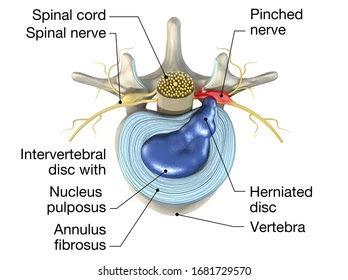Slipped disc aka disc herniation is one of the most popular terms that pop up when you google “low back pain”. So what is it exactly and how do you know you have it?
 https://www.shutterstock.com/image-illustration/3d-illustration-showing-painful-herniated-disc-1681729567
https://www.shutterstock.com/image-illustration/3d-illustration-showing-painful-herniated-disc-1681729567
A disc herniation is when the outer (external) protrusion of the nucleus pulposes of the intervertebral disc through annular fibers. This causes compression of a spinal nerve which we call radiculopathy. It’s most common in your Lumbar spine between L4/L5 and L5/S1 vertebrae. It can cause soft tissue damage which may also cause swelling.
So how does this happen?
Some of the potential causes for this are; chronic overloading of disc, past/repetitive trauma, asymmetrical loading and twisting, poor posture, poor core strength. Patients most at risk for this commonly present with a hyperlordotic (lumbar spine) curve and forward pelvic tilt.
There’s about 4 stages of this:
- Disc Degeneration: chemical changes, repetitive stress or aging of the disc which causes the disc to weaken and the nucleus to shift without a herniation
- Prolapse: position of the disc changes with slight impingement into the spinal canal (called bulge or protrusion)
- Extrusion: nucleus pulpsoses breaks through annulus fibrosis and lies outside of the disc in the spinal canal
- Sequesterd disc: nucleus pulposus breaks through annulus fibrosis and lies outside of the disc in the spinal canal

What are some symptoms?
Everyone is different but here are some common signs and symptoms of a slipped disc.
- Sudden onset of low back pain and leg pain PAST the knee. A lot of times you may have experienced prior frequent episodes of low back pain, but it may not have been as strong as this (again repetitive injuries). The leg pain may actually be more increased than low back pain with a herniation, but you may only have more low back pain with annular tears.
- Sharp, shooting or electrical pain which may follow a dermatome and is significantly increased with intradiscal pressure (eg sneezing, straining, weight bearing, coughing etc). The pain is increased with low back flexion and decreased with extension.
- Low back musculature becomes increasingly tight (e.g. Erector Spina, Quadratus Lumborum etc)
- Muscle weakness with testing, decreased sensation, absent or decreased tendon reflex for 1 dermatome.
The best way to see a disc herniation is a MRI! Research also shows that about 75% of herniations resolve spontaneously within 6 months to a year due to reabsorption of herniated material. It is very common for people to have had a disc herniation 10 years ago that flare’s up again or even a few times after.

https://www.yorkvillesportsmed.com/blog/essentials-of-disc-herniation-bulging-slip-discs
So what can you do about it?
At the initial stages the best thing to do is try to manage the inflammation (icing) and pain. The more you move around the better your prognosis will be. Chiropractic adjustments can help restore normal biomechanics and McKenzie extension exercises may also help. Schedule an appointment with your Chiropractor and they will be able to adjust you using certain techniques which are more beneficial when you are in the initial phases of a disc herniation and provide you with the proper home exercises to help you strengthen your back.
If you would like to schedule an appointment with me click here to book online for a Chiropractic appointment in Winnipeg.


